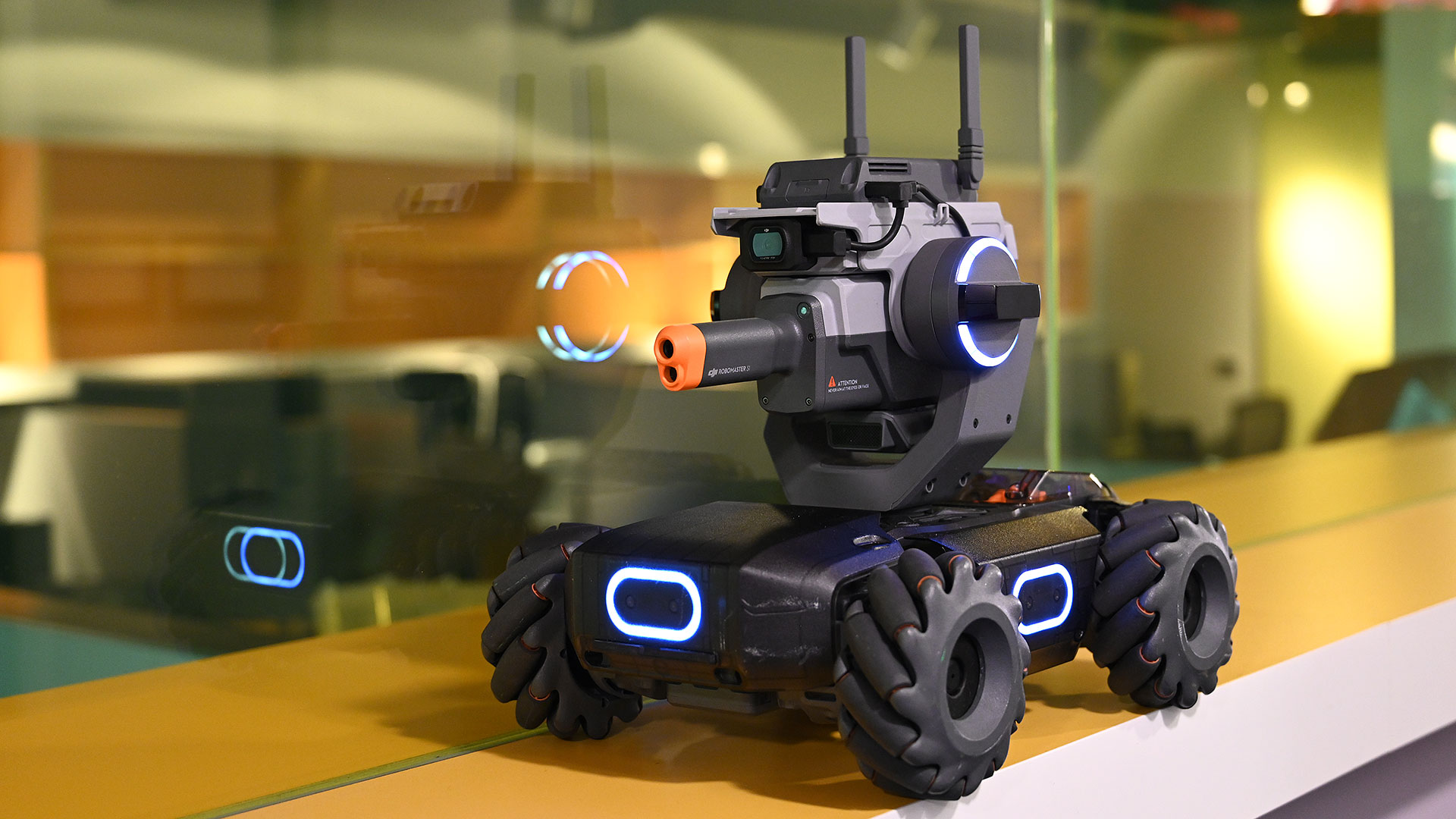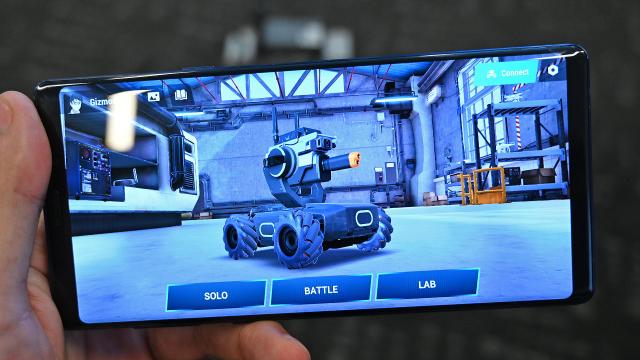The DJI Robomaster S1 is the childhood toy I always wanted. Actually, it’s way better than that. Compared to junk like the Tyco Rebound I had in the 90’s, the Robomaster S1 is faster, more sophisticated, and thanks to its Mecanum wheels, much more nimble than anything my tiny kid brain could have even imagined.
And that’s before you consider the Robomaster’s built-in camera, dual blasters, and its programmability. Only there’s a cost to all this, and with a base price of $US500 ($717), it’s a big one. So is it worth it?
Editor’s Note: This bad boy isn’t available in Australia yet.

DJI Robomaster S1
What is it?
An RC robot that can teach coding skills
Price
$US500 ($717)
Like
Super fast, customisable, built-in camera, dual blasters, easy to setup and operate
Don't Like
Pricey, the gel beads make a mess, only comes with one battery
That’s a harder question to answer because it’s difficult to recommend anyone buy a $US500 ($717) toy, even one as smart and techy as the Robomaster S1. If it gets wheeled out for a week or two and then forgotten after that, then obviously no. But that’s a risk you take when you buy pretty much any toy. However, if it helps someone—especially a child—learn how to code, it could signal the start of a future career. That’s priceless.
So like a lot of things, the Robomaster’s value depends greatly on how much you can get out of it. That’s because while it’s easy to reduce the S1 down something as simple as an RC car, it’s also an educational tool. For starters, while the Robomaster S1 comes assembled, you can use an Allen wrench to remove parts as you see fit, and then add new ones one and integrate them into the bot using the six pulse width modulation ports on its customisable circuit board.
But the real intricacy comes when you dive into the Robomaster’s programming. Almost all of its functions can be changed or tweaked to your liking using two coding languages: Scratch, a simpler more visual language that can be arranged in blocks like Legos, or Python for more experienced coders. Scratch is clearly intended as a way to introduce children to coding, and the ease with which you can create or modify existing instructions makes me feel like if I had access to something similar as a child, I might have been better prepared for Java and C++ in later on in school.
DJI also makes it easy to switch between the two languages, so you can get a better sense of more complicated code running beneath Scratch simply by hitting a button in the top right corner of the Robomaster App. And to help guide users along the way, DJI also includes a Coding Academy, a selection of assorted signs for use in your programs, and a dedicated section in the app for you to save and manage all your projects.
From there you can do things like program the Robomaster to autonomously follow a track, or even mess around with its image and gesture recognition, or expand the Robomaster’s game modes from its default battle and race options. That said, if you are actually considering diving into the Robomasters code, I’d highly recommend setting the Robomaster app up on a tablet rather than a phone for easier viewing and better typing inputs. (The Robomaster app is free and available on both Android and iOS and includes keyboard and mouse support if you’re using the optional controller.)
OK, enough about what you can do with the Robomaster, what is it actually like to use? It’s fast. Like really fast. In fact, when I handed controls of a Robomaster over to some fellow Gizmodo staffers, many remarked that even the bot’s Medium speed setting felt a bit too spritely to handle. There’s also a definite learning curve because unlike a traditional RC car, the Robomaster’s Mecanum wheels allow it to strafe directly to the left or right, which makes piloting the S1 feel more like controlling a character in an FPS game than a tank, as the S1’s outward appearance might suggest.
Depending on your age and familiarity with mobile games, the S1’s controls can take some getting used to as well. For people who have played PUBG Mobile, things should feel quite natural. There’s an on-screen virtual control pad on the left that controls your movement, while the right side of the screen is reserved for aiming the S1’s camera/blaster. And then depending on if you’re racing, battling, or doing something else, there will additional on-screen buttons for shooting the S1’s blasters, activating power-ups, and more.
But for me, after a few minutes of messing about, I felt quite comfortable with the S1’s handling, and soon after was tearing down the halls of my office and generally annoying the crap out of my coworkers. DJI even provides additional settings that let you fine tune things like the S1’s turning speed and other settings. Just be careful, because when driven flat out, you can kill the S1’s batter in 15 minutes or less, which can be kind of a bummer, because recharging its removable battery takes closer to 45 minutes to an hour. This thing really ought to come with a spare power pack in the box.
For folks who prefer more tactile controls, DJI does plan to offer a controller accessory (price still TBA) that attaches to a phone or small tablet and adds a joystick and a handful of buttons. But that’s only a partial solution as you’ll still have to rely on touchscreen controls to aim the S1’s camera.
The Robomaster’s built-in camera is also an essential part of the S1’s Kit. Not only is it much easier to control the bot by looking at the live feed on your phone, but its image quality isn’t bad either. The S1 features a 2,560 by 1,440 camera with a 120-degree field of view, and by using the onboard microSD card reader, you can record all your adventures. There’s also an option to send images directly to your phone, but because that happens over wifi, photos may have reduced quality. That said, because the S1’s camera doesn’t come with a stabilizer or gimbal, video won’t look quite as smooth as you’d get from one of DJI’s drones.
Connecting your phone to the S1 is also dead simple. You can tether it directly to your phone over wifi, or to a router which can offer a slightly better range. In either case, it’s possible to send the Robomaster 50 to 100 feet or more away from your location without worries about dropping your signal.
As for the S1’s blasters, in normal use, they fire green light that can be detected by the sensors on the side of the bot so you can use them to host your own little RC battle royale (which is something I highly suggest). However, if you want to shoot something with a bit more punch, the S1 also has a removable magazine that can be loaded with small gel beads that are slightly larger than a BB pellet. The beads are essentially the same thing as Orbeez and are available in bottles containing around 10,000 shot for $US9 ($13). However, if you opt to go this route, you’ll need a bit of foresight, as the beads start out in a desiccated form, and only become usable after being soaked in water for a few hours.
But once everything is all set up, you can really start making a mess. That’s because while the beads aren’t especially painful (here’s you obligatory please don’t shoot people with the S1), the gel beads tend to shatter into tiny pieces anytime they hit a hard surface, which is partly intentional as that makes the beads easier to clean up with a vacuum.
But the other issue is that the beads are bouncy as hell. After spilling a handful in our office, even a week later I still find myself running into rogue beads every now and then, occasionally stepping on one and grinding it into the carpet.
For safety’s sake, users should always wear protective goggles after turning the blaster’s bead shooting mode on, even though DJI does include a limit on how high the Blaster can aim when live fire is enabled.
Oh, I should add the S1 is really freaking loud. From the sounds of its blasters to the chirp it makes when you turn it on and even the booming voice that tells you when it’s connecting to your phone, the Robomaster S1 isn’t exactly an inconspicuous gadget. Even on carpeted floors, the noise its Mecanum wheels makes means you’re never really going to sneak up on someone unless they’re standing next to traffic. For parents trying to preserve what little quiet time you might have, you’ve been warned.
All told, the DJI Robomaster is a blast, and there’s a small part of my brain that’s upset that stuff like this didn’t exist when I was a kid—even if my parents probably wouldn’t have shelled out $US500 ($717) for one. Something like the Robomaster S1 could have made me more receptive to at least better prepared to learn how to code later in life, and as just a basic RC car, the S1 is some of most fun you can have on four wheels, even wheels as funky as these.
But at $US500 ($717), the Robomaster is more than a toy, it’s almost an investment. You really need to spend a lot of time with it to get your money’s worth. And like owning a single guinea pig (which is illegal in Switzerland by the way), playing with Robomaster S1 is a hell of a lot more fun in pairs. I mean, it’s not really fair when you can shoot other toys if they can’t shoot you back.
README
-
The Robomaster S1 is one part RC battle tank and one part education toy for teaching coding skills.
-
It has two blasters, one which shoots beams and light, and the other which shoots small gel beads.
-
Between its sounds effects, loud Mecanum tires, and various beeps and warning noises, the Robomaster S1 can make quite a racket.
-
The Robomaster S1 is a lot of fun on its own, but it is way better if you have a second bot around.
-
For such a sophisticated toy, the Robomaster S1 can take a real beating.
